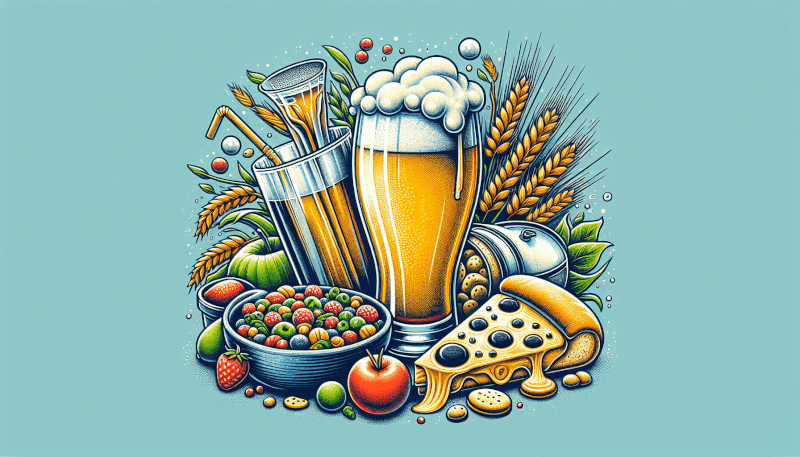Are you an entrepreneur in the food and beverage industry looking to boost your sales and expand your reach? Look no further! In this article, we will explore the world of affiliate marketing and provide you with valuable tips and tricks to help you succeed in this competitive market. Whether you are a restaurant owner, a food blogger, or a manufacturer of delicious treats, we’ve got you covered. Get ready to ignite your business and watch it soar to new heights with the power of affiliate marketing. So, grab a cup of your favorite beverage and let’s get started!

Understanding Affiliate Marketing
Affiliate marketing is a type of performance-based marketing where an individual or company, known as an affiliate, promotes other people’s products and earns a commission for each sale or lead generated through their efforts. In essence, you become a middleman between the consumer and the merchant, helping to drive traffic and sales to the merchant’s website.
How Affiliate Marketing Works
Affiliate marketing works through a four-step process:
- First, you sign up for an affiliate program and receive a unique affiliate link or ID.
- Next, you promote the merchant’s products on your platform, such as a website or blog, by placing affiliate links in your content.
- When a visitor clicks on your affiliate link and makes a purchase or completes a desired action, such as filling out a form, the merchant tracks the referral and attributes it to you as the affiliate.
- Finally, you earn a commission for each successful referral or sale made through your affiliate links.

Benefits of Affiliate Marketing in the Food and Beverage Industry
Affiliate marketing offers numerous benefits for both affiliates and merchants in the food and beverage industry.
For affiliates, it provides an opportunity to earn passive income by promoting products they are genuinely interested in and passionate about. They can leverage their platforms, whether it be a website, blog, or social media presence, to create engaging content and build a loyal audience.
For merchants, affiliate marketing serves as a cost-effective and results-driven marketing strategy. It allows them to tap into a vast network of affiliates who can effectively promote their products to a targeted audience. This, in turn, helps merchants increase brand exposure, drive website traffic, and boost sales.
Choosing the Right Affiliate Program
Researching Different Affiliate Programs
When choosing the right affiliate program, it is essential to conduct thorough research. Look for programs that align with your niche, have a good reputation, and offer competitive commission rates. Consider factors such as the range of products available, cookie duration, payout threshold, and payment schedule.
Identifying Relevant Food and Beverage Affiliate Programs
Look for affiliate programs specifically tailored to the food and beverage industry. These programs will have products that resonate with your target audience and enhance the credibility of your platform. For instance, if you have a food blog, you can join affiliate programs that offer gourmet kitchen supplies, organic food products, or meal delivery services.
Evaluating Commission Structures
Compare commission structures among different affiliate programs to ensure you are receiving a fair and competitive rate. Some programs offer a percentage-based commission, while others offer a fixed amount per sale or lead. Consider the average order value of the products you will be promoting and calculate how much you can potentially earn from each referral.
Considering the Reputation of the Affiliate Program
Choose affiliate programs with a solid reputation in the industry. Look for programs that have been operating for a significant period and have positive reviews from other affiliates. Avoid programs with a history of non-payment or poor merchant support, as this can hinder your success as an affiliate.

Selecting the Right Food and Beverage Products
Identifying High-Quality and Popular Food and Beverage Products
To maximize your success as an affiliate marketer in the food and beverage industry, it is crucial to promote high-quality and popular products. Conduct thorough research to identify products that have a positive reputation, receive favorable customer reviews, and offer unique features or benefits. This ensures that your audience will have a positive experience with the products you recommend, leading to higher conversion rates.
Understanding Consumer Demand and Trends
Stay informed about current consumer demand and trends in the food and beverage industry. This allows you to align your product selection with what your target audience desires. Consider factors such as dietary preferences, health and wellness trends, and sustainable and ethical product options. By catering to these demands, you establish yourself as a trusted source of information and increase the likelihood of driving sales.
Considering Brand Reputation and Credibility
Choose food and beverage products from reputable and credible brands. Consumers are more likely to trust and purchase products from brands they are familiar with and perceive as reliable. Partnering with reputable brands also enhances your own credibility as an affiliate marketer. Research the brand’s history, mission, and values to ensure they align with your own and resonate with your audience.
Building a Niche-Focused Website or Blog
Choosing a Domain Name
Selecting a suitable domain name is a crucial step in building a niche-focused website or blog. Choose a domain name that reflects your platform’s topic or niche, is easy to remember, and aligns with your branding strategy. Consider using keywords related to the food and beverage industry to improve search engine optimization (SEO).
Selecting a Suitable Web Hosting Service
Choose a reliable and reputable web hosting service that can accommodate the needs of your website or blog. Look for features such as fast loading times, responsive customer support, and scalable hosting plans. Consider the specific requirements of your platform, such as the ability to handle high traffic volumes or support e-commerce functionality.
Designing an Attractive and User-Friendly Website
Design your website or blog in a way that is visually appealing and user-friendly. Use a clean and professional layout, choose complementary colors, and ensure easy navigation throughout the site. Optimize your website for mobile devices to cater to the increasing number of users accessing the internet through smartphones and tablets.
Creating Relevant and Engaging Content
Create content that is relevant to your niche and engages your target audience. Publish informative articles, tutorials, recipes, or reviews that provide value and address the needs and interests of your readers. Use a conversational tone to establish a friendly and approachable voice, and include visuals such as images or infographics to enhance the overall user experience.
Optimizing the Website for Search Engines
Implement SEO strategies to improve the visibility of your website in search engine results pages. Conduct keyword research to identify relevant search terms and incorporate them strategically into your content, meta tags, headings, and URLs. Optimize your website’s speed, improve its mobile-friendliness, and build high-quality backlinks from authoritative sources to further boost its SEO performance.
Implementing Effective Call-to-Actions
Include call-to-actions (CTAs) throughout your website to encourage visitors to take the desired action, such as clicking on an affiliate link or signing up for a newsletter. Use persuasive and action-oriented language in your CTAs, and place them strategically within your content or on prominent areas of your website. Test and analyze different CTAs to determine which ones yield the highest conversion rates.

Driving Traffic to Your Affiliate Website
Utilizing Search Engine Optimization (SEO) Strategies
As mentioned earlier, implementing SEO strategies can help drive organic traffic to your affiliate website. Optimize your content with relevant keywords, build high-quality backlinks, and ensure your website is easily crawlable by search engine bots. Regularly update and add fresh content to attract both search engines and users.
Creating Engaging Social Media Profiles
Leverage social media platforms to promote your affiliate website and drive traffic. Create engaging profiles on platforms that align with your target audience’s preferences, such as Facebook, Instagram, or Pinterest. Share valuable content, interact with your followers, and use enticing visuals to capture their attention. Incorporate links to your website or blog in your social media profiles and posts to direct traffic to your affiliate links.
Implementing Email Marketing Campaigns
Build an email list of subscribers who are interested in your niche and eager to receive updates and promotions. Use email marketing to nurture relationships with your audience and drive traffic to your affiliate website. Send regular newsletters, personalized recommendations, exclusive offers, and useful content to keep your subscribers engaged and encourage them to visit your website.
Collaborating with Influencers and Bloggers
Partner with influencers and bloggers who have a significant following in the food and beverage industry. Collaborate on content creation, guest posting, or influencer marketing campaigns to tap into their audience and generate traffic to your website. Ensure that the influencers you collaborate with align with your brand values and have an engaged and relevant audience.
Using Pay-Per-Click (PPC) Advertising
Consider utilizing Pay-Per-Click (PPC) advertising platforms such as Google Ads or social media advertising to drive targeted traffic to your affiliate website. Set a budget, choose relevant keywords or target demographics, and create compelling ad copy. Monitor the performance of your ads, experiment with different variations, and optimize them to maximize click-through rates and conversions.
Creating Effective Affiliate Marketing Content
Writing Informative Product Reviews
Product reviews are a powerful tool for affiliate marketers. Write in-depth and informative reviews that provide an unbiased assessment of the products you are promoting. Include relevant details, such as ingredients, features, benefits, and personal experiences, to help your audience make informed purchasing decisions. Incorporate affiliate links strategically within your reviews to drive traffic and generate sales.
Crafting Compelling Blog Posts
Create blog posts that captivate your audience and establish you as an authority in the food and beverage industry. Write engaging articles on topics that interest your readers, such as recipes, food trends, or health-related content. Use storytelling techniques, include personal anecdotes, and provide valuable insights to keep your readers hooked. Incorporate affiliate links naturally within your content to encourage click-throughs.
Creating Engaging Videos or Tutorials
Video content is highly engaging and can help you connect with your audience on a deeper level. Create videos or tutorials that showcase the food and beverage products you are promoting. Demonstrate how to use the products, share recipes, or provide helpful tips and tricks. Embed your affiliate links in the video descriptions or use overlays to drive traffic to your website.
Utilizing Visual Content
Visual content is essential in capturing your audience’s attention and conveying information effectively. Use high-quality images, infographics, or graphics to enhance your blog posts, product reviews, or social media posts. Visual content can help illustrate your points, provide visual appeal, and encourage your audience to take action.
Including Call-to-Actions in Content
Don’t forget to include call-to-actions within your content to prompt your readers to take the desired action. Whether it’s clicking on an affiliate link, subscribing to a newsletter, or sharing your content, explicitly guide your audience on what to do next. Use persuasive language, visually appealing buttons, or compelling statements to increase the likelihood of conversions.

Tracking and Analyzing Performance
Installing Tracking Pixels or Codes
Install tracking pixels or codes provided by your affiliate program or platform to accurately track the performance of your affiliate links. These codes, typically inserted in the header or footer of your website, help track clicks, conversions, and other valuable data. Regularly check and ensure that the tracking codes are functioning correctly to avoid missing out on commissions.
Using Affiliate Marketing Platforms or Software
Utilize affiliate marketing platforms or software to streamline your tracking and analysis processes. These platforms provide comprehensive reports, robust tracking capabilities, and additional tools to optimize your affiliate marketing efforts. Research and choose a platform that aligns with your specific needs and offers reliable support.
Analyzing Click-Through Rates (CTR)
Monitor and analyze the click-through rates (CTR) of your affiliate links to determine the effectiveness of your promotional efforts. Higher CTRs indicate that your audience is engaged and interested in the products you are promoting. Track the performance of different types of content, such as reviews, blog posts, or videos, to identify which formats generate the highest CTRs.
Monitoring Conversion Rates
Conversion rates are a critical metric for measuring the success of your affiliate marketing campaigns. Analyze the conversion rates of your affiliate links to assess the quality of your traffic and the effectiveness of your content and marketing strategies. Identify any patterns or trends in the products or promotional tactics that lead to higher conversion rates.
Identifying Top-Performing Marketing Channels
Identify the top-performing marketing channels that are driving the most traffic and generating the most conversions. This could include organic search traffic, social media referrals, email campaigns, or paid advertising. Focus on optimizing these channels to maximize your affiliate marketing success. Allocate more resources and effort to the channels that yield the highest ROI.
Optimizing Affiliate Marketing Strategies
Testing and Tweaking Marketing Campaigns
Continuously test and tweak your marketing campaigns to optimize their performance. Experiment with different content formats, promotional strategies, or affiliate programs to identify what resonates best with your audience. Measure and analyze the results of your tests, and make data-driven decisions to refine your campaigns and improve their effectiveness.
Experimenting with Different Affiliate Programs
Don’t limit yourself to one affiliate program. Explore and experiment with different affiliate programs to diversify your income sources and find the ones that work best for your niche and audience. Compare commission rates, product selection, and program policies to make an informed decision. Regularly evaluate your partnerships and make adjustments as needed.
Adjusting Content and Promotional Strategies
Stay flexible and adjust your content and promotional strategies based on the feedback and performance data you receive. Pay attention to the preferences and feedback of your audience, and adapt your content to meet their evolving needs. Experiment with different content formats, promotional channels, or messaging to keep your marketing efforts fresh and engaging.
Staying Updated with Industry Trends and Changes
Stay abreast of industry trends and changes to remain relevant and competitive in the food and beverage market. Monitor emerging food trends, shifts in consumer preferences, or changes in regulations that may impact your marketing strategies. Embrace innovation and adapt your affiliate marketing approach to align with the evolving landscape.
Complying with Legal and Ethical Guidelines
Disclosing Affiliate Relationships
Ensure transparency and maintain the trust of your audience by disclosing your affiliate relationships. Clearly indicate on your website or within your content that you earn a commission from qualifying purchases made through your affiliate links. This disclosure not only complies with legal requirements but also establishes honesty and integrity with your audience.
Following Advertising and Marketing Laws
Adhere to the advertising and marketing laws of your jurisdiction. Familiarize yourself with regulations related to disclosure, testimonials, endorsements, and product claims. Avoid making false or misleading statements about the products you promote. Failure to comply with these regulations can result in legal consequences and damage your reputation.
Ensuring Transparency and Honesty in Promotions
Maintain transparency and honesty in your promotional efforts. Provide accurate and unbiased information about the products you promote. Clearly communicate any limitations, risks, or disclaimers related to the products. Avoid using deceptive or exaggerated claims that could mislead your audience. Prioritize the welfare of your audience over maximizing your own financial gain.
Building and Nurturing Long-Term Relationships
Communicating and Collaborating with Brands and Merchants
Establish open lines of communication with the brands and merchants whose products you promote. Reach out to them, introduce yourself, and express your interest in collaborating. Build a mutually beneficial relationship by providing valuable feedback, sharing success stories, or suggesting promotional opportunities. Collaboration can lead to better terms, exclusive offers, or increased commission rates.
Providing Value and Excellent Customer Service
Focus on providing value to your audience and offering excellent customer service. Respond promptly to inquiries or comments from your readers or customers. Engage with your audience on social media platforms, forums, or through email. Build a reputation as a trusted source of information and a reliable affiliate marketer who genuinely cares about their audience.
Establishing Trust and Credibility
Building trust and credibility is essential for long-term success as an affiliate marketer. Consistently deliver high-quality content that is accurate, helpful, and unbiased. Be transparent about your affiliations and motivations. Establish yourself as an authentic and knowledgeable voice in the food and beverage industry. Over time, your audience will come to trust your recommendations and be more inclined to make purchases through your affiliate links.
Negotiating for Higher Commissions or Exclusive Offers
As your platform grows and your influence increases, don’t be afraid to negotiate for higher commissions or exclusive offers with the brands or programs you work with. Demonstrate the value you provide, such as your engaged audience, high conversion rates, or innovative marketing strategies. Negotiate fair terms that reflect the effort and influence you bring to the table.
Building a successful affiliate marketing business in the food and beverage industry requires dedication, strategic planning, and continuous learning. Keep these tips and tricks in mind as you embark on your affiliate marketing journey and adapt them to fit your specific circumstances and goals. With hard work and persistence, you can turn your passion for food and beverages into a profitable venture.


